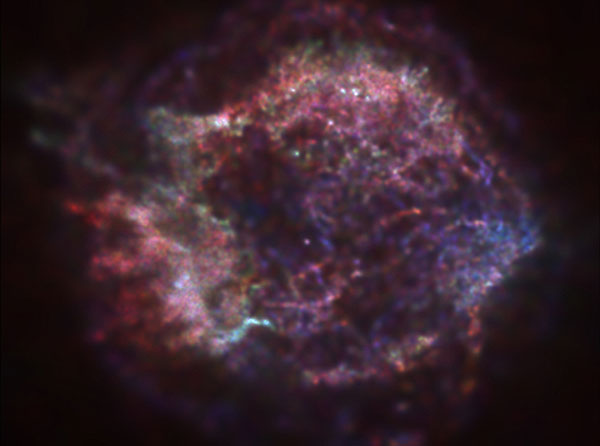
|
Explanation: The complex shell of a star seen to explode 300 years ago is helping astronomers to understand how that star exploded. The above recently released image of supernova remnant Cassiopeia A (Cas A) shows unprecedented detail in three X-ray colors. The relationship between brightness, color, and position of material in the image indicates where in the star this material was just before the explosion. Bright knots on the left, for example, contain little iron, and so are hypothesized to originated from a higher layer than outer red filaments, which are iron rich. The blue region on the right is seen through absorbing dust, and so appears depleted of low-energy X-rays. It takes light ten years to cross the gas shell of the Cas A supernova remnant, which is 10,000 light-years distant. Most of the elements that make people and planets were produced in supernova explosions.
|
January February March April May June July August September October November December |
| |||||||||||||||||||||||||||||||||||||||||||||||||||||||
NASA Web Site Statements, Warnings, and Disclaimers
NASA Official: Jay Norris. Specific rights apply.
A service of: LHEA at NASA / GSFC
& Michigan Tech. U.
Based on Astronomy Picture
Of the Day
Publications with keywords: Cas A - supernova remnant - supernova
Publications with words: Cas A - supernova remnant - supernova
See also:
- APOD: 2025 October 1 Á NGC 6960: The Witchs Broom Nebula
- APOD: 2025 July 31 Á Supernova 2025rbs in NGC 7331
- APOD: 2025 June 9 Á Between Scylla and Charybdis: A Double Cosmic Discovery
- Supernova Remnant Cassiopeia A
- APOD: 2025 January 8 Á Supernova Remnants Big and Small
- APOD: 2024 September 18 Á The Mermaid Nebula Supernova Remnant
- APOD: 2024 April 16 Á Filaments of the Vela Supernova Remnant
